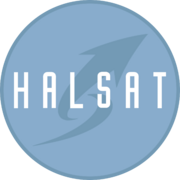HALSAT
Hallanisk Särskild Aeronautik och Teknik Organisation
Hallæisk Særlig Aeronautik og Teknologiorganisation | |
 Forward Together | |
| Abbreviation | HALSAT |
|---|---|
| Formation | 3 March 1967 |
| Headquarters | 101 Västerut Street, Valhamn, Svaldheim |
Official language | Crethian, Svaldish, Tuskish |
Administrator | Maren Rasmussen |
| Sormenniemi Space Centre Complex, Sormenkohta, Velsken | |
Parent organisation | |
Budget | |
| Website | www.halsat.org |
The Hallanic Special Aeronautics and Technology Organisation (Svaldish: Hallanisk Särskild Aeronautik och Teknik Organisation, Tuskish: Hallæisk Særlig Aeronautik og Teknologiorganisation), more commonly known by the acronym HALSAT, is a transnational space agency and intergovernmental organization comprising the four Hallanic states, committed to space exploration.
Founded in 1967 as a merger of the Svaldish and Tuskish space programs, HALSAT was founded with the dual aims of consolidating the smaller national programs and fostering pan-Hallanic friendship. Crethia would commit in 1969, and HALSAT would emerge as a tertiary competitor in the Gaian space race, and was one of the primary signatories to the Pekrasta Extraterrestrial Arms Treaty. HALSAT is primarily responsible for civilian space exploration and technological development, in addition to the launch of satellites and humans into orbit. It has also conducted more advanced missions, such as moon landings, and is currently preparing for a mission to Mars.
HALSAT is headquartered at 101 Västerut Street, in the Svaldish capital of Valhamn, while the organisation's primary launch facility is the Sormenniemi Space Centre Complex near the southern Velskeni city of Sormenkohta. The organisation is largely administered by the Director-General, which is currently Maren Rasmussen, a former Tuskish astronaut.